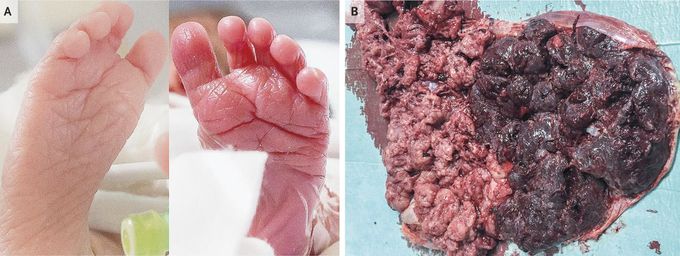


Twin Anemia Polycythemia Sequence
Physical examination of monochorionic, diamniotic identical twins (i.e., sharing a single placenta but having separate amniotic sacs) who were born at 31 weeks of gestation showed a pallid first twin and a plethoric second twin (Panel A). The placenta had marked color asymmetry (Panel B), and pathological analysis revealed pale, friable vessels from the first twin and congested vessels from the second twin. Findings from routine transabdominal ultrasonography that had been performed at 30 weeks of gestation were suggestive of twin anemia polycythemia sequence (TAPS). Repeated ultrasonography performed 6 days later revealed oligohydramnios in the first fetus and polyhydramnios in the second fetus, which was indicative of twin-to-twin transfusion syndrome (TTTS). Laboratory results after birth showed a hemoglobin level of 6.9 g per deciliter in the pallid twin and 25.5 g per deciliter in the plethoric twin (reference range, 15 to 19). TTTS is a condition in which relative hypovolemia develops in one twin and hypervolemia in the other. TAPS is a form of TTTS caused by the slow transfusion of red cells through small placental anastomoses, resulting in anemia in one twin and polycythemia in the other. The first twin received a transfusion of one unit of packed red cells; the second twin underwent phototherapy and two cycles of exchange transfusion. The two twins were discharged after 39 days and had normal development at the 12-month follow-up.
My twins had TTTS when they were born 22 years ago at 33 weeks. 2 pounds 3 ounces and 5 pounds 11 ounces. Both are graduating with engineering degrees. These babies are resilient!
In which hospital these case study done can be detailed


